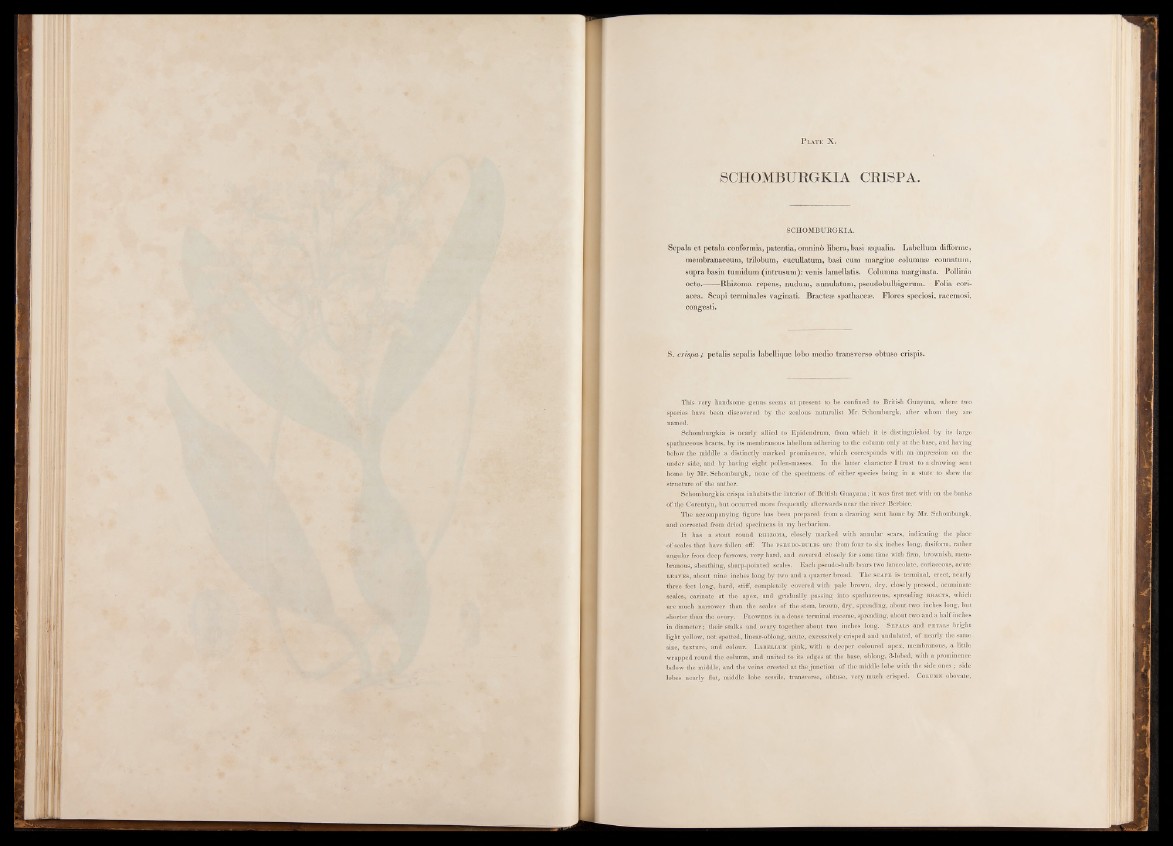
P late X.
SCHOMBURGKIA CRISPA.
SCHOMBURGKIA.
Sepala et petala conformia, patentia, omnind libera, basi sequalia. Labellum difforme,
membranaceum, trilobum, cucullatum, basi cum margine columnee connatum,
supra basin tumidum (intrusum): venis lamellatis. Columna marginata. Pollinia
octo.------Rhizoma repens, nudum, annulatum, pseudobulbigerum. Folia coriacea.
Scapi terminales vaginati. Bracteae spathaceee. Flores speciosi, racemosi,
congest!.
S. crispa; petalis sepalis labellique lobo medio transverso obtuso crispis.
This very handsome genus seems at present to be confined to British Guay ana, where two
species have ' been discovered by the zealous naturalist Mr. Schomburgk, after whom they are
named.
Schomburgkia is nearly allied to Epidendrum, from which it is distinguished by its large
spathaceous bracts, by its membranous labellum adhering to the column only at the base, and having
below the middle a distinctly marked prominence, which corresponds with an impression on the
under side, and by having eight pollen-masses. In the latter character I trust to a drawing sent
home by Mr. Schomburgk, none of the specimens of either species being in a state to shew the
structure of the anther.
Schomburgkia crispa inhabits the interior of British Guayana; it was first met with on the banks
of the Corentyn, but occurred more frequently afterwards near the river Berbice.
The accompanying figure has been prepared from a drawing sent home by Mr. Schomburgk,
and corrected from dried specimens in my herbarium.
It has a stout round rhizoma, closely marked with annular scars, indicating the place
of scales that have fallen off. The pseudo-bulbs are from four to six inches long, fusiform, rather
angular from deep furrows, very hard, and covered closely for some time with firm, brownish, membranous,
sheathing, sharp-pointed scales. Each pseudo-bulb bears two lanceolate, coriaceous, acute
leaves, about nine inches long by two and a quarter broad. The scape is terminal, erect,nearly
three feet long, hard, stiff, completely covered with pale brown, dry, closely pressed, acuminate
scales, carinate at the apex, and gradually passing into spathaceous, spreading bracts, which
are much narrower than the scales of the stem, brown, dry, spreading, about two inches long, but
shorter than the ovary. F lowers in a dense terminal raceme, spreading, about two and a half inches
in diameter; their stalks and ovary together about two inches long. Sepals and petals bright
light yellow, not spotted, linear-oblong, acute, excessively crisped and undulated, of nearly the same
size, texture, and colour. Labellum pink, with a deeper coloured .apex, membranous, a. little
wrapped round the column, and united to its edges at the base, oblong, 3-lobed, with a prominence
below the middle, and the veins crested at the junction of the middle lobe with the side ones ; side
lobes nearly flat, middle lobe sessile, transverse, obtuse, very much crisped. Column obovate,